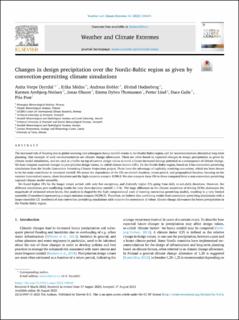| dc.contributor.author | Dyrrdal, Anita Verpe | |
| dc.contributor.author | Médus, Erika | |
| dc.contributor.author | Dobler, Andreas | |
| dc.contributor.author | Hodnebrog, Øivind | |
| dc.contributor.author | Arnbjerg-Nielsen, Karsten | |
| dc.contributor.author | Olsson, Jonas | |
| dc.contributor.author | Thomassen, Emma Dybro | |
| dc.contributor.author | Lind, Petter | |
| dc.contributor.author | Gaile, Dace | |
| dc.contributor.author | Post, Piia | |
| dc.date.accessioned | 2024-03-04T10:00:20Z | |
| dc.date.available | 2024-03-04T10:00:20Z | |
| dc.date.created | 2023-09-14T08:46:54Z | |
| dc.date.issued | 2023 | |
| dc.identifier.citation | Weather and Climate Extremes. 2023, 42 . | en_US |
| dc.identifier.issn | 2212-0947 | |
| dc.identifier.uri | https://hdl.handle.net/11250/3120835 | |
| dc.description.abstract | The increased risk of flooding due to global warming and subsequent heavy rainfall events in the Nordic-Baltic region, call for recommendations directed at long-term planning. One example of such recommendations are climate change allowances. These are often based on expected changes in design precipitation as given by climate model simulations, and are used as a buffer on top of current design values to avoid a future increased damage potential as a consequence of climate change. We here compute expected changes in precipitation design values, so-called climate factors (CFs), for the Nordic-Baltic region, based on 3 km convection permitting simulations from the Nordic Convection Permitting Climate Projections project. These have the advantage of explicitly resolving convection, which has been shown to be the main contributor to increased rainfall. We assess the dependence of the CFs on rainfall duration, return period, and geographical location, focusing on the summer (convective) season, short durations and the high emission scenario RCP8.5. We also compare these CFs to those computed from a non-convection permitting regional climate model ensemble. We found higher CFs for the longer return period, with only few exceptions, and distinctly higher CFs going from daily to sub-daily durations. However, the different simulations give conflicting results for very short-duration rainfall (<3 h). The huge difference in the climate sensitivity of driving GCMs dominates the magnitude of estimated return levels. Our analysis is shaped by the high computational costs of running convection permitting models, resulting in a very limited ensemble (3 members) representing a single emission scenario (RCP8.5). Therefore, we believe that combining results from convection permitting simulations with a larger ensemble (21 members) of non-convection permitting simulations adds value to the assessment of robust climate change allowances for heavy precipitation in the Nordic-Baltic region. | en_US |
| dc.language.iso | eng | en_US |
| dc.publisher | Elsevier | en_US |
| dc.rights | Navngivelse 4.0 Internasjonal | * |
| dc.rights.uri | http://creativecommons.org/licenses/by/4.0/deed.no | * |
| dc.title | Changes in design precipitation over the Nordic-Baltic region as given by convection-permitting climate simulations | en_US |
| dc.title.alternative | Changes in design precipitation over the Nordic-Baltic region as given by convection-permitting climate simulations | en_US |
| dc.type | Peer reviewed | en_US |
| dc.type | Journal article | en_US |
| dc.description.version | publishedVersion | en_US |
| dc.source.pagenumber | 0 | en_US |
| dc.source.volume | 42 | en_US |
| dc.source.journal | Weather and Climate Extremes | en_US |
| dc.identifier.doi | 10.1016/j.wace.2023.100604 | |
| dc.identifier.cristin | 2174929 | |
| dc.relation.project | Norges forskningsråd: 302457 | en_US |
| dc.relation.project | Miljødirektoratet: MD - KSS_Klimaservicessenter/Klima-i-Norge (251060) | en_US |
| dc.relation.project | Norges forskningsråd: 275589 | en_US |
| cristin.ispublished | true | |
| cristin.fulltext | original | |
| cristin.qualitycode | 1 | |

